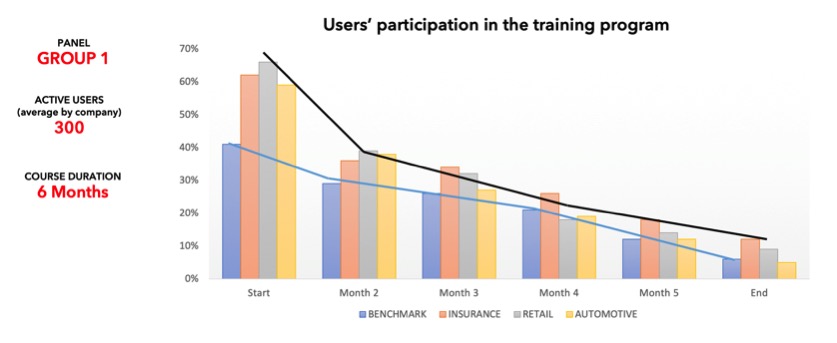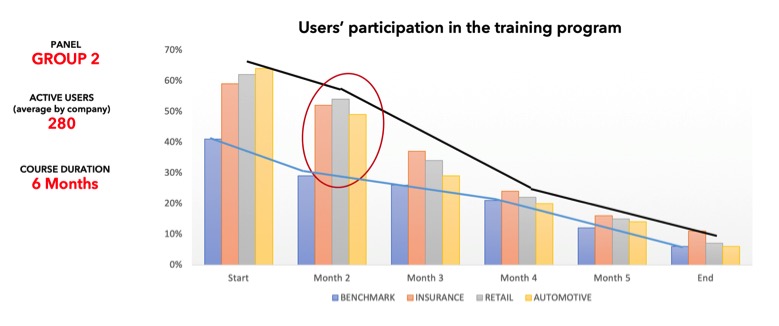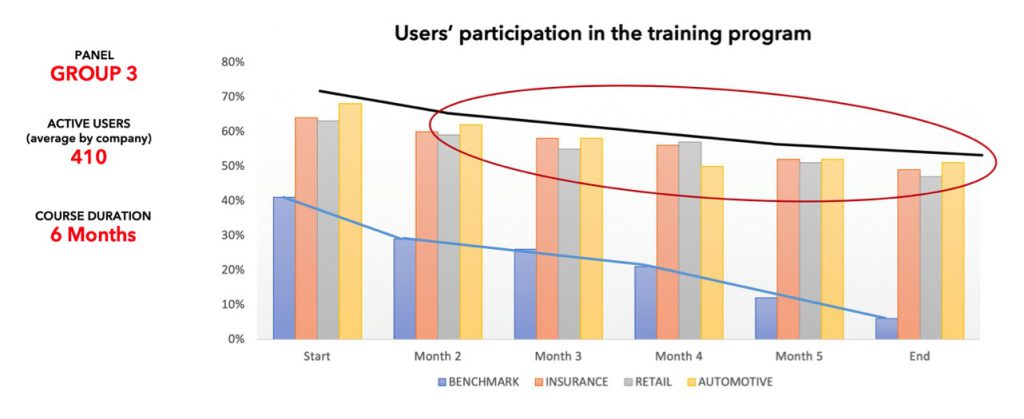
As an L&D and Leadership Development professional, you know that one of the biggest challenges when it comes to digital learning is about ensuring that users consistently access the learning contents, keeping pace with your proposed schedule.
This becomes an even greater reality and more important when the subject revolves around soft skills and participation goes beyond click-and-pass the test.
Still most companies struggle to get users online for training purposes, and many initiatives that look brilliant in the beginning never take off for lack of long-term active users traffic.
Why trainees systematically lose their grip on soft skills’ online training courses? How can you improve traffic and engagement?
Why trainees systematically lose their grip on soft skills online training courses? How can you improve traffic and engagement?
Today I will try to answer these questions by reflecting on the case studies of three different large companies from three different industries: Insurance, Retail and Automotive.
We have provided them with our SkillGym Digital Role Play system and what follows is the description of how they implemented this tool overtime.
Specifically, we helped them to improve their delivery strategy using a 3-step approach.
Each step lasted six months and was dedicated to the deployment of a specific set of Digital Role Play with a specific population (which we will call Group 1, 2, 3).
The set of Digital Role Play was different for each company as was the type of population.
This point is very important since, as you will read below, it highlights the fact that the evidence we collected is independent from the industry, the topic and the type of trainees.
Step 1: Is “learning by doing” the key to engaging users?
The strategy behind the first wave of deployment was supported by the idea that delivering a smart and interactive program such as SkillGym was enough to keep users on track.
A significant launch event was organized at each of the three companies and, at the beginning, the novelty of digital role playing was perceived by users as something to look at.
Our Customer Success team was monitoring the ongoing activity of the online training program and the overall result was summarized as follows:

Look at the distribution of usage in the first group. The blue bar represents a benchmark, the average engagement per month of what I would call a “knowledge transfer” as part of a voluntary digital learning program. This average emerged by one of our previous in-field research studies.
The new strategy generated a great deal of engagement in the first month by almost doubling user engagement as compared to the traditional digital learning course that we used as a benchmark.
However, starting in the second month, things started to fade, and the participation slowly dissipated (even though the drop was by a lower percentage as compared to the “old way” shown by the blue benchmark).
At SkillGym, we were quite impressed by this. Everyone (including us, by the way) was talking about “learning by doing” is the real magnet of any engagement. Evidence has shown that it was not enough.
Changing the learning approach toward a more interactive practice is at the foundation of real behavioral change on soft skills, however, it was not the secret trick to keeping users engaged long term. And, of course, no engaged users, no usage, no improvement – regardless of learning approach.
Step 2: Leveraging F.O.M.O.
So, preparing for the second semester and group of trainees, we decided to tweak this basic engagement strategy and add some flavor in the form of “FEAR OF MISSING OUT”.
Basically, we introduced some additional metrics (available to the trainees) to the training dashboard.
Sourcing from our extensive BIG DATA (consider that we delivered Digital Role Plays to over 300,000 trainees worldwide over the past 6 years), the new dashboard showed and compared one’s own result with those of colleagues (in anonymous way, of course) and with comparable profiles from all around the world.
Guess what happened? We scored a month’s longer engagement.
That’s cool:

We started to learn that, in order to develop a good delivery strategy aimed at consistent training engagement over time, you can’t just rely on one single factor. Especially when enrollment and participation is voluntary, and the time span extends for 6 months.
In order to develop a good delivery strategy aimed at consistent training engagement over time, you can’t just rely on one single factor.
Step 3: Leveraging habits
Our third step was set up in the third semester of this training initiative. In order to get a handle on why participation levels declined over time, we surveyed trainees about why engagement in the training program declined for them.
A common response was along the lines of, “I have other priorities scheduled…”
So, we started to observe that each of us, as human beings, is hard-wired to a calendar-based way to schedule the day’s activities. I am sure that any of you also tend to stick to your calendar schedule, no matter what.
In the event that you can’t make it to a scheduled appointment, you advise those involved and reschedule (feeling a bit sorry for the cancellation).
It’s a HABIT. So, we decided to LEVERAGE HABITS to “change habits”.
This is where our scheduling system called SkillGym Butler was born. We designed one automatic scheduling tool inside SkillGym to increase the emotional engagement and commitment of users towards their scheduled individual training program.
- Once the individual training path was defined, the SkillGym Butler started to send to the trainees periodic Doodle Invitations to schedule one Role Play on their busy calendar
- Each trainee was free to choose the preferred date and time of the meeting and an appointment was scheduled on the calendar, just like it would happen with real life meetings
- Close to the appointment date, SkillGym Butler sent reminders to the trainee and, in case of late show or cancellation, a re-schedule procedure was set up
Look at the curves…engagement exploded! People are so used to sticking to their calendar that the simple fact of scheduling one life-like meeting turned the trend upside down. There is a scientific basis to this.
As you certainly know, numerous scientific studies have demonstrated that our brain does not differentiate between real life and simulation.
Moreover, the fact that the tool used for the training is focusing on a conversation with somebody else (and SkillGym makes it very life-like) enhanced the sense of obligation.
Keeping the momentum
Like any other initiative, success is a mix of several factors, the quality of the contents being just one of them. Here at SkillGym, we tend to consider the quality of the contents as well as the strength and depth of the learning methodology as the founding pillars of behavioral change.
However, we know that such change happens only if people practice consistently over time. And we are fully aware that the noise out there is so loud that each of us tend to ignore whatever is not fitting our strict calendarized priority list.
That’s where we learned how to leverage this habit of sticking to the daily checklist that we all call “calendar”.
Does it mean that simply by scheduling the learning activities on trainees’ calendars turns a lousy training course into one of the year’s greatest hits? Certainly not. Many other ingredients concur to maintain the momentum.
Let’s look at five key ingredients that must be in place to start paving the way toward real training engagement:
- First, creating the momentum. Any training activity has to be promoted and advertised among the trainees right from the start. Based on our experience, L&D departments are very good at this and, of course, the availability of social digital channels is a great ally for viral diffusion of a learning initiative.
- Endorsing and framing the initiative. At the same time, it is very important to provide trainees with a sense of why they should put effort in your learning initiative. Again, we see that L&D professionals are very aware of the importance of framing the scope of a training program. However, the message becomes much more powerful when it is endorsed by the senior management. We see some misalignments here, which often leads to a weaker message spreading among trainees.
- Providing activities that are perceived as useful. Whatever the advertising, it’s ultimately about the contents. If the training course is perceived as meaningful and useful, you will have opportunity to win. Otherwise, no matter what effort you put into promotion, people will quickly realize that it’s not worth their effort.
- Showing clear signs of improvement. No one wants to keep training if improvements are not apparent. Don’t forget that it’s not about whether or not improvements are achieved; it’s about letting them know that improvements are achieved. So, provide metrics. Sound metrics, showing very clearly that it is worth putting forth the effort.
- Challenging the FOMO. Even better, show them how all the others are improving too. Benchmarking, when done in a properly and with utmost care when handling individual personal data privacy, is one of the most powerful fuels to push commitment ahead.
Even if all those ingredients are in place, the corporate training strategy is all to often:
- Either positioning the course as mandatory, which certainly increases the formal participation, but typically decreases the real and genuine involvement;
- Or letting the trainees free to organize their attendance (“it’s digital, doesn’t mean you can play when you want and reap great advantages?”), with the result that “when you want” quickly turns into “later on” and then into “never”.
That’s where SkillGym Butler makes the difference. Users are still free to organize their training schedule as they want, but once a meeting is set on their calendar, the Butler will make sure that it is perceived as so real that sticking to the underlying commitment becomes… just a habit.
Scale the training engagement, lower the organizational effort
Not only SkillGym Butler:
- Keeps track of each trainee’s schedule
- Turns training into appointments
- Monitors the trainee’s reliability to scheduled conversation
- Delivers smart reminders when needed…
It does all this automatically!
This is the key to the success of SkillGym Butler: a huge advance in engagement strategy at almost no organizational cost from the point of view of trainers.
With SkillGym Butler, trainers do not need to remember to send reminders and can, finally, dedicate their time to the most precious activity of analyzing the results from practice and adjusting the overall training strategy accordingly.
I hope this case study was as inspiring to you, as it was to us here at SkillGym.
We learned a lot from observing how habits can be leveraged through smart engagement strategies. Today we are proud of considering the Butler as one of the key ingredients in our recipe for developing conversational leadership.
Tell us about your story in the Comment section and let’s continue this conversation.
Of course, we would be delighted to show you SkillGym’s solution in a 1-hour discovery call.


